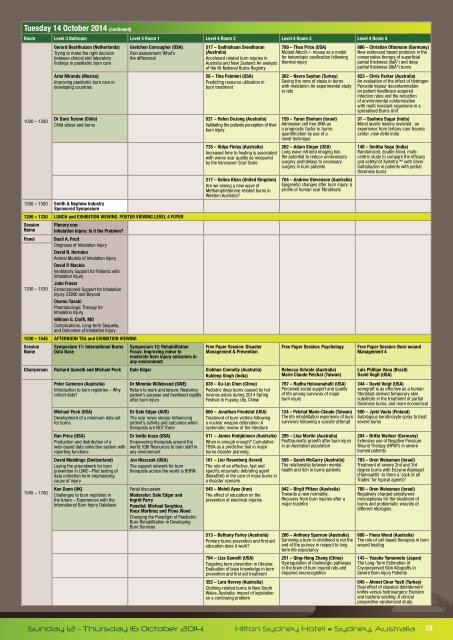ISBI-2014-PROGRAM-08102014
ISBI-2014-PROGRAM-08102014
ISBI-2014-PROGRAM-08102014
You also want an ePaper? Increase the reach of your titles
YUMPU automatically turns print PDFs into web optimized ePapers that Google loves.
Tuesday 14 October <strong>2014</strong>Room Level 3 Ballroom Level 4 Room 1 Level 4 Room 2 Level 4 Room 3 Level 4 Room 41030 – 1200Gerard Beerthuizen (Netherlands)Trying to make the right decisionbetween clinical and laboratoryfindings in paediatric burn careAriel Miranda (Mexico)Improving paediatric burn care indeveloping countriesDr Dare Turene (Chile)Child abuse and burnsGretchen Carrougher (USA)Pain assessment: What’sthe difference!1200 – 1300 Smith & Nephew IndustrySponsored Symposium1200 – 1330 LUNCH and EXHIBITION VIEWING. POSTER VIEWING LEVEL 4 FOYERSessionNamePanel1330 – 1530Plenary one:Inhalation Injury: Is it the Problem?Basil A. PruitDiagnosis of Inhalation InjuryDavid N. HerndonAnimal Models of Inhalation InjuryDavid P. MackieVentilatory Support for Patients withInhalation InjuryJohn FraserExtracorporeal Support for InhalationInjury: ECMO and BeyondOsamu TasakiPharmacologic Therapy forInhalation InjuryWilliam G. Cioffi, MDComplications, Long-term Sequella,and Outcomes of Inhalation Injury1530 – 1545 AFTERNOON TEA and EXHIBITION VIEWINGSessionNameSymposium 11: International BurnsData BaseSymposium 12: RehabilitationFocus: Improving minor tomoderate burn injury outcomes inany environment517 – Sadhishaan Sreedharan(Australia)Accelerant related burn injuries inAustralia and New Zealand: An analysisof the Bi-National Burns Registry58 – Tina Palmieri (USA)Predicting resource utilization inburn treatment521 – Helen DeJong (Australia)Validating the patients perception of theirburn injury735 – Vidya Finlay (Australia)Increased time to healing is associatedwith worse scar quality as measuredby the Vancouver Scar Scale217 – Selina Khan (United Kingdom)Are we seeing a new wave ofMethamphetamine-related burns inWestern Australia?Free Paper Session: DisasterManagement & PreventionChairperson Richard Gamelli and Michael Peck Dale Edgar Siobhan Connolly (Australia)Kuldeep Singh (India)1545 – 1700(continued)Peter Cameron (Australia)Introduction to burn registries – Whycollect data?Michael Peck (USA)Development of a minimum data setfor burnsRon Price (USA)Production and distribution of aweb-based data collection system withreporting functionsDavid Meddings (Switzerland)Laying the groundwork for burnprevention in LMIC--Pilot testing ofdata collection form emphasizingcause of injuryKen Dunn (UK)Challenges to burn registries inthe future – Experiences with theInternational Burn Injury DatabaseDr Mimmie Willebrand (SWE)Return to work and leisure: Restoringpatient’s purpose and livelihood rapidlyafter burn injuryDr Dale Edgar (AUS)The scar never sleeps: Influencingpatient’s activity and outcomes whentherapists are NOT thereDr Ivette Icaza (USA)Empowering therapists around theworld: <strong>ISBI</strong> Resources to train staff inany environmentJon Niszczak (USA)The support network for burntherapists across the world is BORNPanel discussion:Moderator: Dale Edgar andIngrid ParryPanelist: Michael Serghiou,Roux Martinez and Fiona WoodChanging the Paradigm of PaediatricBurn Rehabilitation in DevelopingBurn Services838 – Xu-Lin Chen (China)Pediatric deep burns caused by hotincense ashes during <strong>2014</strong> SpringFestival in Fuyang city, China666 – Jonathan Friedstat (USA)Treatment of burn victims followinga nuclear weapon detonation: Asystematic review of the literature511 – James Hodgkinson (Australia)When is enough enough? CumulativeTBSA as a predictive tool in majorburns disaster planning.161 – Lior Rosenberg (Israel)The role of an effective, fast andspecific enzymatic debriding agent(NexoBrid) in the care of mass burns ina disaster scenario545 – Mehdi Ayaz (Iran)The effect of education on theprevention of electrical injuries513 – Bethany Farley (Australia)Primary burns prevention and first aideducation does it work?794 – Liza Gamelli (USA)Targeting burn prevention in Ukraine:Evaluation of base knowledge in burnprevention and first aid treatment352 – Lara Harvey (Australia)Clothing-related burns in New SouthWales, Australia: impact of legislationon a continuing problem789 – Thea Price (USA)Mutant Abcc6-/- mouse as a modelfor heterotopic ossification followingthermal injury362 – Nevra Seyhan (Turkey)Saving the zone of stasis in burnswith melatonin: An experimental studyin rats159 – Yaron Shoham (Israel)Admission cell free DNA asa prognostic factor in burns:quantification by use of anovel technique262 – Adam Singer (USA)Long wave infrared imaging hasthe potential to reduce unnecessarysurgery and||delays to necessarysurgery in burn patients704 – Andrew Stevenson (Australia)Epigenetic changes after burn injury: aprofile of human scar fibroblastsFree Paper Session: PsychologyRebecca Schrale (Australia)Marie Claude Pelchat (Taiwan)787 – Radha Holavanahalli (USA)Perceived social support and qualityof life among survivors of majorburn injury124 – Pelchat Marie-Claude (Taiwan)The life rehabilitation experience of burnsurvivors following a suicide attempt295 – Lisa Martin (Australia)Posttraumatic growth after burn injuryin an Australian population558 – Sarah McGarry (Australia)The relationship between mentalhealth and itch in burns patients942 – Birgit Pfitzer (Australia)Towards a new normality:Recovery from burn injuries after amajor bushfire286 – Anthony Sparnon (Australia)Surviving a burn in childhood is not theend of the journey in respect to longterm life expectancy251 – Qing-Hong Zhang (China)Dysregulation of cholinergic pathwaysin the brain of burn injured rats andimpaired neurocognition886 – Christian Ottomann (Germany)New evidenced based protocols in theconservative therapy of superficialpartial thickness (IIa°) and deeppartial thickness (IIb°) burns823 – Chris Parker (Australia)An evaluation of the effect of HydrogenPeroxide Vapour decontaminationon patient healthcare acquiredinfection rates and the reductionof environmental contaminationwith multi resistant organisms in aspecialised Burns Unit31 – Sushma Sagar (India)Morel lavelle lesions revisited : anexperience from tertiary care traumacenter ,new delhi india148 – Smitha Segu (India)Randomized, double-blind, multicentricstudy to compare the efficacyand safety||of Xylentra with SilverSulfadiazine in patients with partialthickness burnsFree Paper Session: Burn woundManagement 4Luis Phillipe Vana (Brazil)David Vogit (USA)344 – David Voigt (USA)xenograft is as effective as a humanfibroblast-derived temporary skinsubstitute in the treatment of partialthickness burns, and more economical590 – Jyrki Vuola (Finland)Autologous keratinocyte spray to treatsevere burns204 – Britta Wallner (Germany)Extensive use of Negative PressureWound Therapy (NPWT) in severeburned patients783 – Oren Weissman (Israel)Treatment of severe 2nd and 3rddegree burns with Enzyme Alginogel(Flaminal®) -Is there a ‘Jack of allTrades’ for topical agents?785 – Oren Weissman (Israel)Negatively charged polystyrenemicrospheres for the treatment ofburns and problematic wounds ofdifferent etiologies690 – Fiona Wood (Australia)The role of cell based therapies in burnwound healing143 – Yusuke Yamamoto (Japan)The Long-Term Estimation ofCryopreserved Skin Allografts inSevere Burn Injury Patients645 – Ahmet Cinar Yasti (Turkey)Dual effect of classical debridementknifes versus hydrosurgery: Excisionand bacteria seeding. A clinicalprospective randomized study.Sunday 12 – Thursday 16 October <strong>2014</strong> Hilton Sydney Hotel • Sydney, Australia 23


